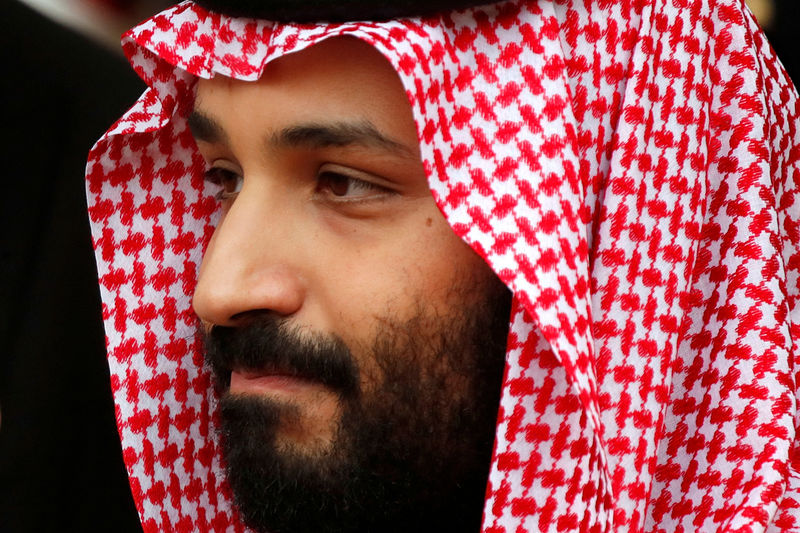By Barani Krishnan
Investing.com -- Crude prices fell Tuesday amid reports that the on-off meeting between President Joe Biden and Saudi Arabia’s crown prince was on again, raising the prospects that Washington might be able to squeeze a little more oil off OPEC to offset the global supply tightness that has sent U.S. fuel prices and inflation soaring.
Oil hit 14-week highs earlier in the day, with U.S. crude soaring to almost $124 a barrel and U.K. Brent breaching $125 after the Organization of the Petroleum Exporting Countries stuck with its forecast that world oil demand will exceed pre-pandemic levels in 2022. This was in spite of OPEC admitting that Russia's invasion of Ukraine and developments around the coronavirus pandemic pose a considerable risk.
But as the session wore on, concerns grew about U.S. inflation ripping at its highest since 1981 and the likelihood that the Federal Reserve might impose a rate hike as high as three quarters of a percentage point, versus initial speculation for a half point hike, at the conclusion of its monthly policy meeting Wednesday.
The Dollar Index hit a two-decade high of 105.39 against a basket of six major currencies on speculation over the larger Fed rate hike. Benchmark U.S. bond yields, led by the return on the 10-year Treasury note, hit an 11-year peak of 3.49%.
Adding to the weight on oil were reports that Biden will meet Saudi Crown Prince Mohammed bin Salman during a trip to the Middle East in July, in a break with his campaign pledge of making the kingdom a "pariah" as he struggles to combat record high U.S. gasoline prices.
London-traded Brent, the global oil benchmark, settled down $1.10, or almost 1%, at $121.17 a barrel. It earlier hit a March high of $125.16.
New York-traded West Texas Intermediate, the benchmark for U.S. crude, settled down $2, or 1.7%, at $118..93 per barrel, after a three-month high of $123.66.
Just a couple of weeks ago, Biden had played down the prospects of such a meeting with the crown prince, commonly referred to by his initials as MbS.
But a senior U.S. official, speaking on condition of anonymity, was quoted telling Reuters on Tuesday that if Biden "determines it's in his interest to engage with any particular leader, and if such an engagement can deliver results, then he will do so."
The official pointed to MbS’ role in helping secure an extension of a U.N.-brokered truce between Yemen's warring parties as an example of what he said was a need to engage with Saudi Arabia as a way to help bring peace and security to the region.
But all that talk seemed to avoid the elephant in the room — the question of whether the meeting would lead to better personal relations between Biden and the crown prince, who is Saudi Arabia’s king-in-waiting. MbS needs unequivocal U.S. support for Saudi Arabia in the Yemen war and for Biden to address Gulf concerns about Iran's missile program and its regional proxies. The U.S. president simply needs more oil from OPEC.
A mere nod from MbS would allow his kingdom, which effectively controls the 13-nation OPEC and its 10 oil producing allies, including Russia, to open their oil spigots a little more, providing some relief to American consumers struggling from fuel prices at record highs of $5 a gallon or more.
“I’ll put down today’s oil price reversal to the ‘MbS put’,” said John Kilduff, founding partner at New York energy hedge fund Again Capital. “The Saudis can move oil prices now at a whim with whatever they decide, and nobody is more powerful in Saudi Arabia than the crown prince, with the exception of his father, the king himself, of course.”
Oil prices were also pressured in late trading by reports that U.S. Senate Finance Committee chair Ron Wyden plans to introduce legislation setting a 21% surtax on oil company profits considered excessive. The bill would apply a 21% additional tax on excess profits of oil and gas companies with more than $1 billion in annual revenue, the aide said.
Market participants were also on the lookout for U.S. weekly oil inventory data, due after market settlement from API, or the American Petroleum Institute.
The API will release at approximately 4:30 PM ET (20:30 GMT) a snapshot of closing balances on U.S. crude, gasoline and distillates for the week ended June 10. The numbers serve as a precursor to official inventory data on the same due from the U.S. Energy Information Administration on Wednesday.
For last week, analysts tracked by Investing.com expect the EIA to report a crude stockpile drop of 1.31 million barrels, versus the 2.03-million barrel rise reported during the week to June 3.
On the gasoline inventory front, the consensus is for a build of 1.07 million barrels over the 812,000-barrel decline in the previous week.
With distillate stockpiles, the expectation is for a climb of 292,000 barrels versus the prior week’s gain of 2.59 million.
